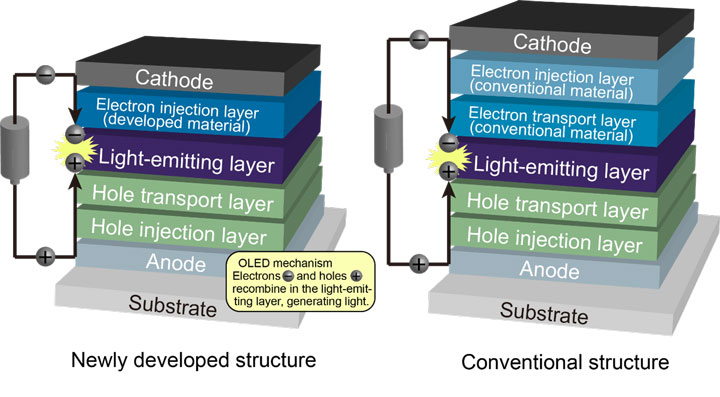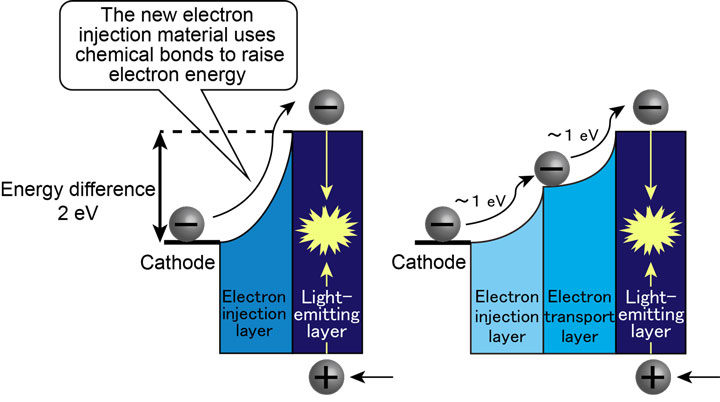

NHK: “Bending” organic EL display: New material development
NHK Science & Technical Research Laboratories:
We aim to “realize a large-screen flexible display that can be wound and folded.”
NHK and Nippon Shokubai:
For the first time in the world, we have elucidated the electron injection operation mechanism with an organic EL display.
May 12,
NHK Science & Technical Research Laboratories, in collaboration with Nippon Shokubai
Collaboratively developed a new high-performance electron injection material.
Properties of OLED:
In organic EL
To inject electrons into the light emitting layer
Between the cathode of the organic EL and the light emitting layer
It is necessary to make the energy difference of 2eV zero.
Newly developed electron injection material:
-Achieves zero energy difference-
With the newly developed electron injection material
Utilizing chemical bonds with cathodes and organic materials
We succeeded in reducing the energy difference to zero.
new discovery:
further,
“Conventional organic EL / electron transport material” is more important than the role of transporting electrons.
Rather, he also clarified that “the role of reducing the energy difference by about 1 eV is large.”
No need for electronic transport materials:
With these discoveries, “if a new electron injection material is used, an electron transport material is unnecessary”.
As a result, electrons can be injected directly into the light emitting layer.
(Impress Watch) –Yahoo! News
https://news.yahoo.co.jp/articles/2fde5abd22c1cc7428e02c94a69d091b6a6ec15e
OLED Electron Injection Mechanism Explained
NHK Science & Technology Research Laboratories (NHK STRL)
is conducting R&D on organic light-emitting-diode (OLED)1) devices, with the goal of realizing flexible, large-screen displays that can be folded or rolled up.
To extend the lifetime of flexible displays and reduce power consumption,
NHK STRL has developed an electron injection layer (EIL) material, which injects electrons from the cathode into the light emitting layer2).
At this time, we give the first-ever explanation of the electron injection mechanism and have developed a new EIL material that will further improve performance*.
To inject electrons into the light-emitting layer in an OLED device,
the energy difference of approximately 2 eV between the cathode and the light-emitting layer must be reduced to zero.
We have explained, for the first time,
how the EIL material we have developed uses its chemical bonds with the neighboring material reduce this difference to zero.
We have also explained how the electron transport material used in conventional OLED devices
reduces this energy difference by approximately 1 eV, which is an even more important role than transporting the electrons.
These discoveries have shown that with the new EIL material, the electron transport material is no longer needed, and it can inject electrons directly into the light-emitting layer.
The new EIL material will contribute to extending the lifetime and reducing power consumption of OLED devices
and also simplify the structure of OLED devices, since the electron transport material is no longer needed.
These research results were published in the May 11 edition of Nature Communications.
We are continuing R&D to create flexible displays with longer lifetime and lower power consumption as soon as possible.
NHK STRL